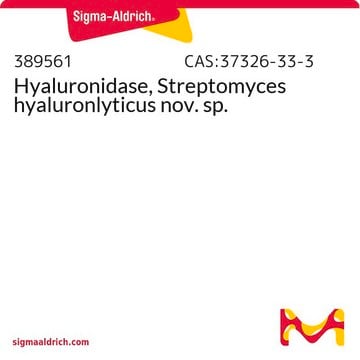The solubility of H375, Hyaluronidase from bovine testes, is 100 mg/mL in water. To achieve a higher solubility, it is advised to warm the tube at 37°C and shake it in an ultrasonic bath for a period. The stock solution can be stored at temperatures below -20°C for several months.
H3757
Hyaluronidase from bovine testes
Type VIII, lyophilized powder, 300-1,000 U/mg
Synonym(s):
Hyaluronate 4-glycanohydrolase, Hyaluronoglucosaminidase
Select a Size
$116.00
Available to ship onApril 08, 2025Details
Select a Size
About This Item
$116.00
Available to ship onApril 08, 2025Details
Recommended Products
biological source
bovine testis
Quality Level
conjugate
conjugate (Glucosaminoglycan)
type
Type VIII
form
lyophilized powder
specific activity
300-1,000 U/mg
mol wt
~55 kDa (four subunits of 14 kDa each)
relevant disease(s)
cancer
storage temp.
−20°C
Gene Information
cow ... HYAL1(515397) , HYAL2(281838)
Looking for similar products? Visit Product Comparison Guide
Related Categories
Biochem/physiol Actions
Unit Definition
Preparation Note
Other Notes
signalword
Danger
hcodes
pcodes
Hazard Classifications
Resp. Sens. 1
Storage Class
11 - Combustible Solids
wgk_germany
WGK 3
flash_point_f
Not applicable
flash_point_c
Not applicable
ppe
Eyeshields, Gloves, type N95 (US)
Choose from one of the most recent versions:
Certificates of Analysis (COA)
Don't see the Right Version?
If you require a particular version, you can look up a specific certificate by the Lot or Batch number.
Already Own This Product?
Find documentation for the products that you have recently purchased in the Document Library.
Customers Also Viewed
Articles
Explore the role of hyaluronan, hyaluronic acid structure, hyaluronan synthesis & degradation, and more. Find GAGs, hydrogels, and scaffold kits.
Uncover more about glycosaminoglycans and proteoglycans including the structure of glycosaminoglycans (GAGs), the different types of GAGs, and their functions.
Glycosaminoglycans are large linear polysaccharides constructed of repeating disaccharide units.
Protocols
To measure hyaluronidase activity, a turbidimetric determination assay is used at 600 nm. One unit of hyaluronidase activity will cause a change in absorbance of 0.330 per minute at pH 5.35 at 37 °C.
-
What is the recommended method for reconstituting item H375, Hyaluronidase from bovine testes?
1 answer-
Helpful?
-
-
Good Morning, I our lab we got this product (H3757) and we would like to know how to obtain the package insert since we are not sure how to store it or after open expiration date. Not lot number on the bottle so not sure how to look for it. Thank you
1 answer-
Hyaluronidase from bovine testes may be reconstituted at 1 mg/mL in 0.02 M sodium phosphate buffer, pH 7.0 containing 77mM sodium chloride and 0.01% bovine serum albumin. For more information please view the assay below:
Helpful?
-
-
How is product H3757, Hyaluronidase from bovine testes, solubilized?
1 answer-
Product H3757, Hyaluronidase from bovine testes, may be reconstituted at 1 mg/mL in 0.02 M sodium phosphate buffer, pH 7.0 containing 77mM sodium chloride and 0.01% bovine serum albumin.
Helpful?
-
-
What is the Department of Transportation shipping information for this product?
1 answer-
Transportation information can be found in Section 14 of the product's (M)SDS.To access the shipping information for this material, use the link on the product detail page for the product.
Helpful?
-
Active Filters
Our team of scientists has experience in all areas of research including Life Science, Material Science, Chemical Synthesis, Chromatography, Analytical and many others.
Contact Technical Service










